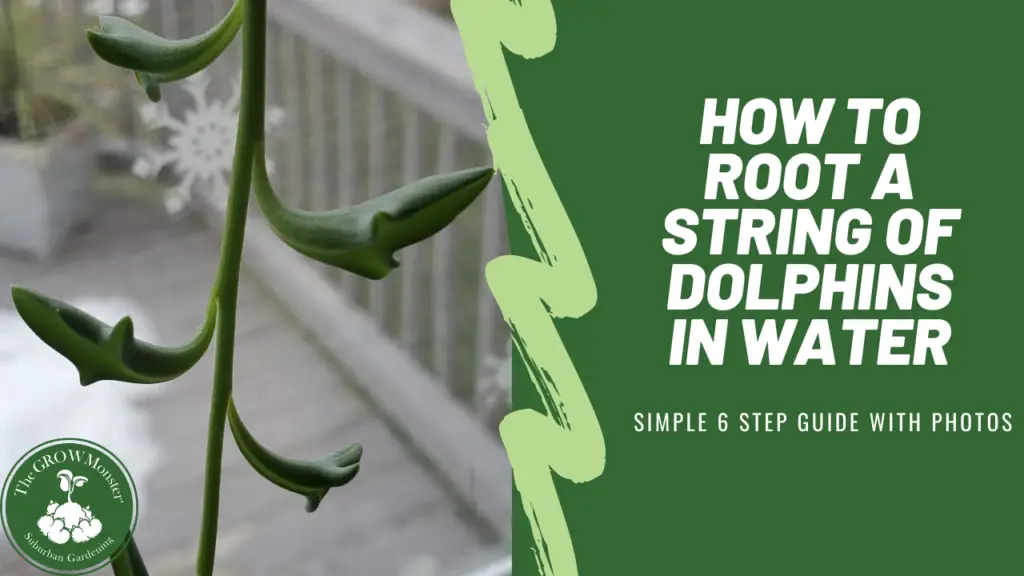When The Grow Monster first started to write about our gardening experiences, we reached out to the local community for any extra gardening plants and supplies that people no longer wanted. The response was pretty good and we received a number of tools and materials to use in our garden along with cuttings and seeds from various plants. One of those cuttings included the rare String of Dolphins (Senecio Peregrinus) hybrid plant.
You can root a String of Dolphins in water using the following steps:
- Find a Healthy Stem and Make the Cut
- Pare Down the Pod
- Wrap in Damp Paper Towel for Transport
- Dip Stem in Root Hormone (Optional)
- Place Cutting in Water
- Transplant the Cutting to Soil
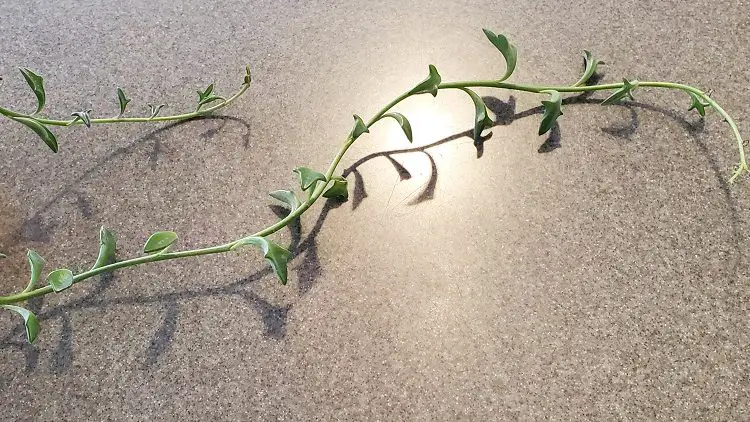
When we received the cutting, The Grow Monster knew very little about this plant until we started researching, and what makes this plant rare is that it is a hybrid of two other succulents: the String of Pearls (Senecio Rowleyanus) and the Candle Plant (Senecio Articulatus). Howard Griffiths and Jamie Males at the Department of Plant Sciences at the University of Cambridge mention how succulents can take on what they call ‘grotesque monstrosities and exotic curiosities’ in the article titled: ‘Primer – Succulent Plants‘. The Grow Monster finds The String of Dolphins to be a specimen of ‘exotic curiosity’ and worthy of further propagation. Read on to learn how to root a String of Dolphins plant.
Find a Healthy Stem and Make the Cut
Before you root a String of Dolphins in water you want to begin with finding and preparing a healthy stem (pod of dolphins). You want to improve your chances of a good cutting by beginning with a good stem. This means the section of plant is not diseased, damaged, wilting, or lacking leaves (dolphins). You will also want a String of Dolphins stem with plenty of dolphins on a 5″-6″ segment. You want to keep the pod together as they say. Once you have found a good segment of dolphins, go ahead and make the cut with a clean knife right below the leaf node so that the node will be included with the cutting.
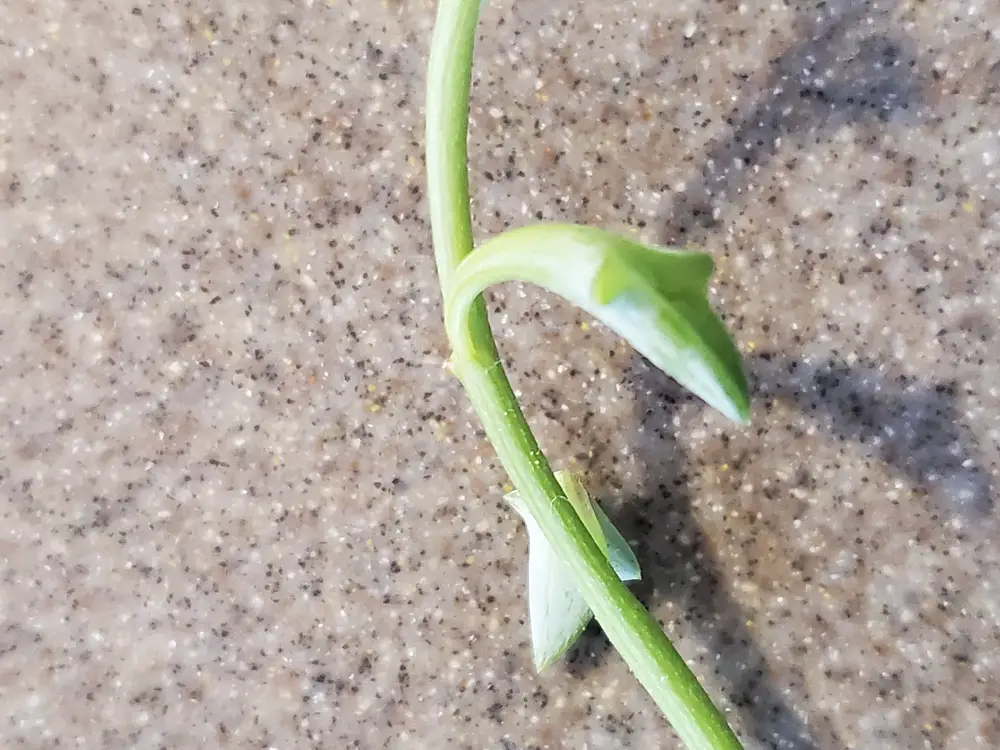
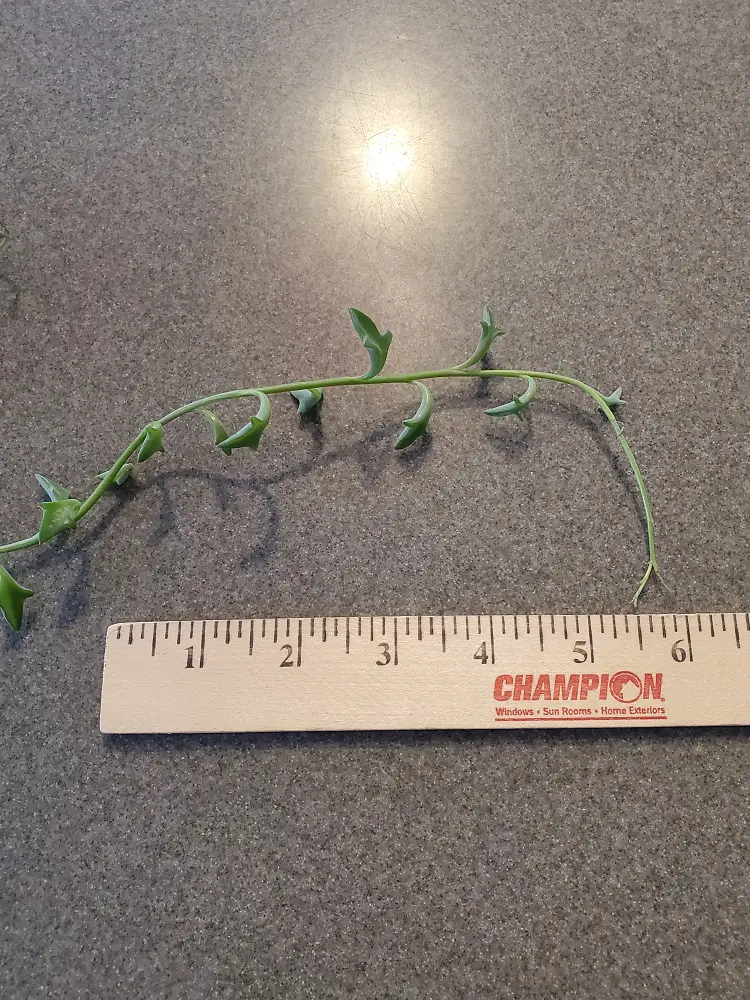
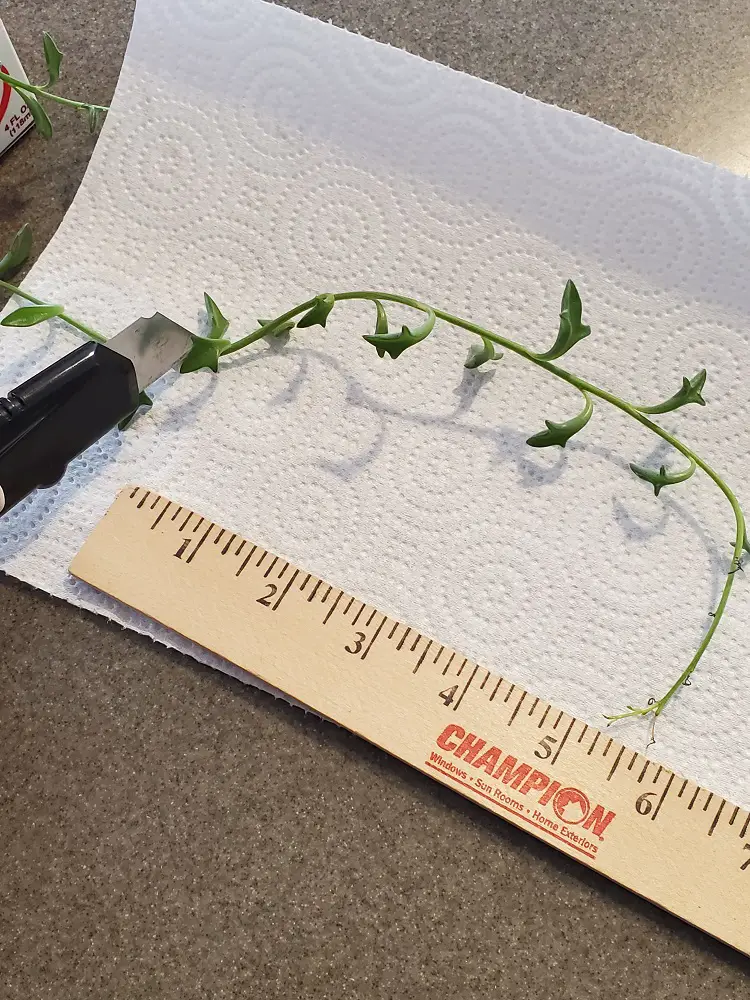
Pare Down the Pod.
The next thing you want to do -and this may be difficult for some- is to pare down the dolphin pod. This means pulling off the last three or four leaves (dolphins) from the end of the segment. This is a sacrifice for the greater good of the pod. Do not despair as this sacrifice will provide the pod with a good foundation to root a String of Dolphins in the future.
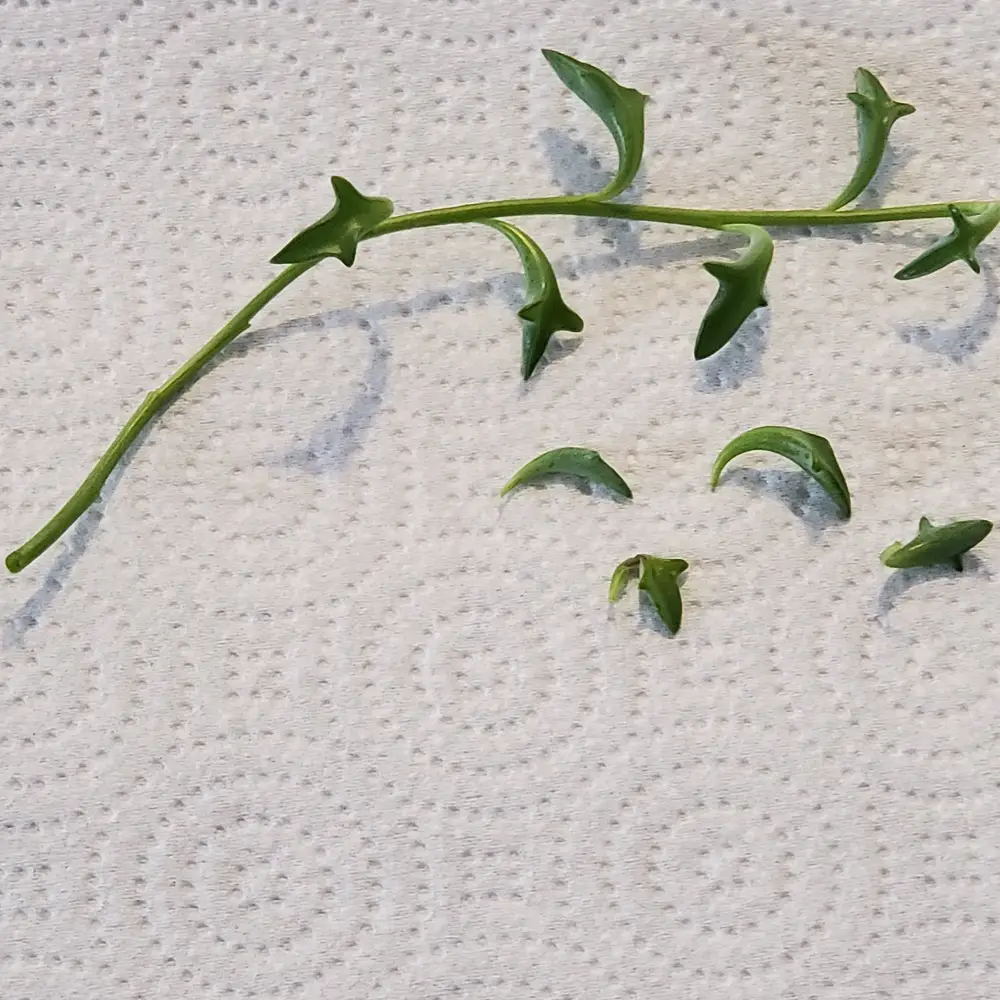
What to do with the three or four discarded dolphins?
Typically, as with preparing any cutting, those leaves get discarded as part of the propagation process. However, many succulents have the unique ability to create cuttings from just their leaves. The leaves of typical succulents are packed with nutrients and with the right conditions, could generate roots. Although an initial web search may say it is not possible to root a String of Dolphins by their leaves, the lack of results stating so may suggest it might still be probable.
The Grow Monster loves to experiment so look forward to another article on how to root succulents by their leaves (Leaf Section Propagation) and see if we are able to get our succulents to root from leaves. If you have already done this, or have the time and want to venture into the unknown, you may want to take a stab at propagating the dolphins by their leaves and report back to us in the comments below.
Wrap in Damp Paper Towel for Transport
Most likely you will be taking a String of Dolphins cutting from a host plant that is not from in your home. It might be a friend or neighbor that is providing the cutting for you to root a String of Dolphins and you need a way to keep the cutting moist while you transport it and prepare it for it’s new home. The best way to do that is by placing the cutting in a moist paper towel. You can then place the moist paper towel and cutting into a larger bag.
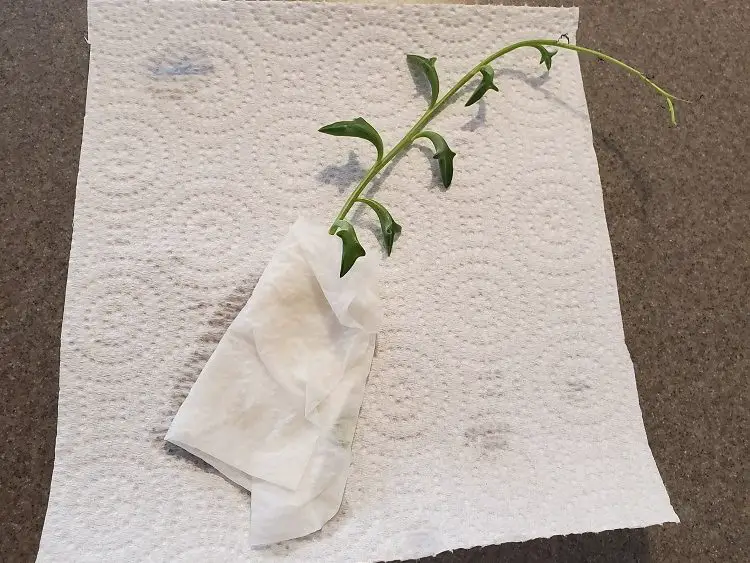
This will prevent the cutting from drying out. This method is preferred to placing the cutting directly in a container of water during transport as an open container might splash and swish around while being transported. You risk spillage and damage to the cutting, but using a paper towel will make the experience will much less messy.
(Some might suggest leaving the cutting in the damp paper towel until the cutting roots. That is fine as well, though just be sure the paper towel remains damp throughout the process and may require extra attention . Also be aware that the fragile roots might grow into the fibers of the paper towel and might break off when jostled or transplanted.)
Dip Stem in Root Hormone (Optional)
Once you have reached your destination and prepared your work space, you can remove the cutting from the paper towel. Dip the lower portion of the cutting segment into the hormone per the hormone product directions. You will want to ensure that the three or four nodes from the sacrificed dolphins get covered liberally with hormone. This is an optional step and it may improve the chances of survival for the dolphin pod as this will promote the growth of new roots sooner. The Grow Monster has successfully grown it’s String of Dolphins without the use of root growth hormone so this step is optional.
(Some might suggest that you apply the root hormone to the stem and return it back to the damp paper towel to let root a String of Dolphins. That is fine as well, though just be sure the paper towel remains damp throughout the process and may require extra attention. Also be aware that the fragile roots might grow into the fibers of the paper towel and might break off when jostled or transplanted. )
Place Cutting in Water to Root a String of Dolphins
The next thing you will want to do is place the String of Dolphins cutting in water in a place with plenty of indirect sunlight. Roots will start to appear within a 3 or 4 week period. Throughout this time period, you need to ensure that the water level remains high enough to cover the 3 or 4 nodes where the discarded dolphins once were. It is from these leafless nodes where new roots will begin. Change out the water every couple of days to keep it fresh and disease-free. When you begin to see significant root growth (over 1 inch in length) from all 3 or 4 nodes, it is time to transplant.
Place a stone over the cutting in the water to keep it from moving around or falling out of the container.
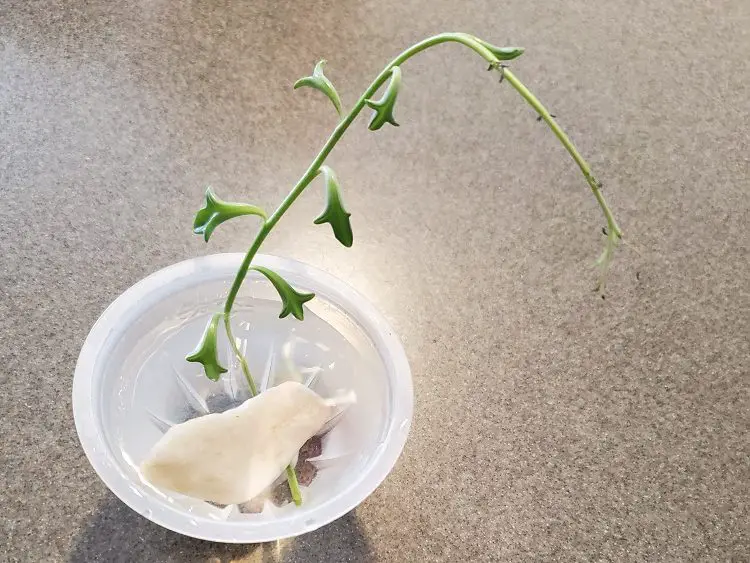
Transplant the Cutting to Soil
Find a good pot to place the cutting in. We recommend a good terracotta pot as these pots will absorb any additional moisture out of the soil and generally come with an adequate drainage hole at the bottom. Make sure the pot comes with a saucer to collect excess water.
Next, prepare a good soil for the String of Dolphins pod to transplant into and take root. Again, the String of Dolphins plant is a succulent. Succulents need a soil that drains well, so a good cactus soil will be perfect for transplanting the String of Dolphins into. This will include any combination of perlite, pumice, and sand with a soil pH range between 6 and 7.5.
Gently transplant the cutting into the soil – as succulent roots are fragile and break easy. After transplanting, water until the soil is moist and not sopping wet. Let the top surface of the soil dry out between watering as you would any succulent. Do not let the water pool, and ensure water is draining out of the bottom when done.
The Grow Monster has gone several days in between watering our String of Dolphins. Each dolphin stores up lots of water so you do not need to water as often as other house plants. Beware to not over-water as the dolphin pod will suffer if given too much water. Even though they are dolphins, they don’t like swimming in lots of water.
Final Thoughts
The String of Dolphins is an interesting hybrid of a plant and it certainly has peaked The Grow Monster’s attention. Considering that it is the by-product of two other succulent varieties, it is a rare plant indeed. Propagating from cuttings is the most widely used method for the String of Dolphins where propagation by seed is not a reliable method because you need two separate kinds of plants to essentially flower at the same time in order to get a seed that ‘might’ have the genetic combination required to create the String of Dolphin hybrid. With that said, we are honored to be the proud owner of a String of Dolphins variety.
If you’d like to learn more about starting your plants from seed, check out our photo guide in the article How to Quickly and Easily Germinate Seeds.

